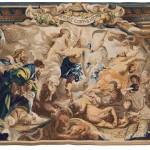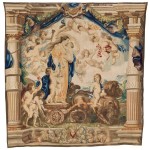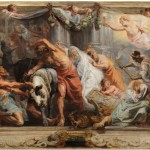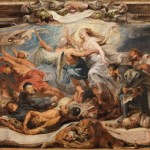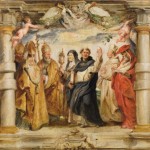Subscribe to Our Newsletter
Peter Paul Rubens: Weaving a Narrative
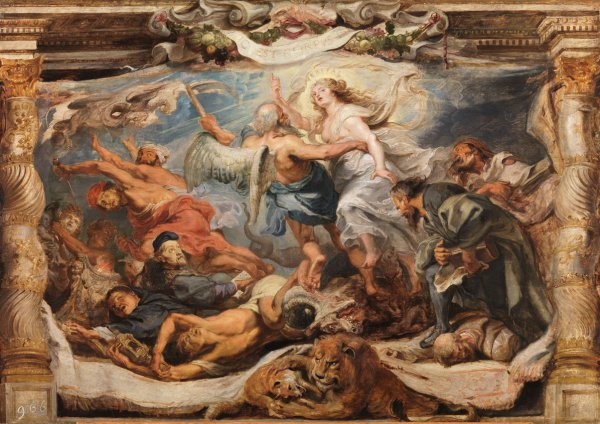
In the service of the Catholic Church and the Spanish royal family, Peter Paul Rubens conceived a cycle of religious images, painted them, and had them rendered as sumptuous tapestries, now on view in a once-in-a lifetime traveling exhibition.
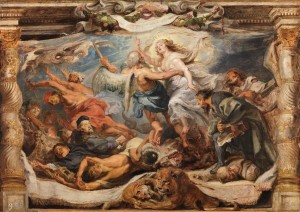
Peter Paul Rubens, The Victory of Truth over Heresy, c. 1625, oil on panel.
Featured Images: (Click to Enlarge)
- Woven by Jacob Geubels II after designs by Peter Paul Rubens, The Victory of Truth over Heresy, c. 1625-33, wool and silk;
- Peter Paul Rubens, The Triumph of Divine Love, c. 1625, oil on panel.
- Peter Paul Rubens, Rubens, The Victory of the Eucharist over Idolatry, c. 1625, oil on panel;
- Peter Paul Rubens, The Victory of Truth over Heresy, c. 1625, oil on panel.
- Peter Paul Rubens, The Defenders of the Eucharist, c. 1625, oil on panel.
The Museum of Fine Arts, Houston is currently host to a remarkable exhibition commemorating one of the most important painters of the early modern period and the translation of his designs into another medium. “Spectacular Rubens” brings together tapestries from the series “The Triumph of the Eucharist,” commissioned in the early 1620s by the Infanta Isabella Clara Eugenia, daughter of King Philip II of Spain, with Peter Paul Rubens’ initial oil sketches for the series. The show, organized by the Museo del Prado in Madrid and the J. Paul Getty Museum in Los Angeles, and previously shown at both venues, offers a unique glimpse into one of the most significant commissions of the Counter-Reformation.
In 2011, the Prado received a grant from the Getty Foundation to begin conservation on the museum’s six modelli (oil sketches) for “The Triumph of the Eucharist.” The grant was part of the foundation’s Panel Paintings Initiative, a project launched in 2008 to train professionals in the conservation of artworks on wood and to increase public awareness of the need for such work. At some point in their history, the Prado panels were enlarged in order to make then uniform in size and shape. With time, these added supports put further structural stress on the panels, leaving them prone to warping and splitting. “Spectacular Rubens” marks not only the completion of their conservation but also the union of the six modelli with 4 of the 20 monumental tapestries. Now, 400 years later, they remain preserved in their original location, the Franciscan convent of the Descalzas Reales (Barefoot Royals) in Madrid, which was founded in 1556 by Isabella’s aunt the Infanta Juana. Since its members were drawn entirely from the ranks of the nobility, who brought their dowries with them, the convent was among the richest in Europe in the 17th century.
Isabella’s legacy as a key figure in Habsburg patronage is immortalized in “The Triumph of the Eucharist,” a completely original Counter-Reformation graphic narrative conceived by Rubens in consultation with the Infanta and her retinue of theological advisors. Isabella’s nephew King Philip IV appointed her Governor-General of the Spanish Netherlands after the death of her husband, Archduke Albert VII, in 1621. Despite her wish to retire in widowhood to the Descalzas Reales, Isabella’s political presence in the north proved too valuable in the eyes of the king, and as early as 1622, Isabella ordered the tapestries from Rubens as a gift to the convent she had wished to enter. The 20 tapestries depict a variety of stories, including Old Testament prefigurations of the Eucharist like The Meeting of Abraham and Melchizedek, allegorical triumphs like The Triumph of Divine Love, and scenes containing figures from the New Testament and Christian history like The Defenders of the Eucharist.
In the 16th and 17th centuries, the Catholic Church, faced with the religious and political challenge of Protestantism, sought to reaffirm its centrality. A major aspect of this effort, known as the Counter-Reformation, was the use of the arts as propaganda. Elaborate productions in diverse media were financed by the Church as well by Catholic nobility across Europe. Rubens, as a devout Catholic, a diplomat, and one of the best-known artists of the period, was the perfect candidate for a commission of this scale. And in typical Counter-Reformation fashion, he used the secular theme of the triumph—an ancient Roman celebration of war victory that was popularized in Renaissance Italy—and applied it in a religious context.
Rubens worked initially from bozzetti, or small, preliminary oil sketches, later painting the larger and much more detailed modelli, and finally overseeing his own workshop in the creation of cartoons made to the proposed scale of the tapestries for use by the weaving workshops. For David Bomford, Director of Conservation and head of European Art at the Museum of Fine Arts, Houston, the modelli represent the culmination of Rubens’s technical and intellectual virtuosity. “It’s such an underused word these days, but I actually think he was a genius that he could actually create these compositions, and he created 20 of them just out of his head,” Bomford says. “There was a certain theological program that he agreed upon with the Infanta Isabella, but then he could devise different scenes that illustrate that and just paint them. Apart from the little sketches, he just made it all up, there on the panel, and it’s astonishing, really, that he was that creative, but also that he was such an extraordinary painter that he could paint these amazing figures straight out of head, straight onto the panel.”
Rubens’ incredibly inventive designs were woven over the course of approximately eight years, between 1625 and 1633, by at least four master weavers working in two of the most prestigious Brussels workshops, those of Jan Raes I and Jacob Geubels II, both of whom had previously worked to adapt other large-scale sketches by Rubens to the loom. Still, Rubens closely supervised the weavers’ work to ensure fidelity to his designs. Isabella acquired the modelli and cartoons with the purchase of the tapestries, which may have cost as much as 130,000 florins, an enormous sum given that a middle-class individual at that time could have lived comfortably on 1,500 to 3,000 florins annually. The modelli later moved to various private collections before the six in this exhibition entered the Spanish Royal Collection and subsequently the collection of the Prado.
In addition to the six Prado modelli and four of the Decalzas Reales tapestries, the Houston installation includes four of the bozzetti, the smallest and earliest designs, on loan from the Fitzwilliam Museum. These bozzetti were not part of the Prado or Getty installations, and while the tapestries are very faithful to the larger Prado oil sketches, the bozzetti give the viewer an even fuller sense of Rubens’ process and shifting artistic choices. For instance, in the six-inch bozzetto for The Defenders of the Eucharist, a composition depicting seven saints from Christian history, Rubens had initially painted Saint Clare, who presents the Eucharist in a grand, gilded monstrance, with her face shown in profile, turned away from the viewer. His decision in the larger modello to face Saint Clare toward the audience and to assign her the Infanta’s own features is just one example of Rubens modifying his ideas in painted form.
Balancing these tiny oils against their large-scale counterparts in wool and silk without overwhelming the viewer proved to be a difficult task in staging the Houston installation. “The challenges of the exhibition are having an installation that could take care of a 24-foot wide tapestry and a 9-inch square bozzetto in the same space,” Bomford notes. This meant building smaller walls for the panels adjacent to those on which the tapestries are hung in the museum’s iconic Cullinan Hall, designed by Mies van der Rohe, as well as painting the walls, which are typically white, a midnight blue. “It’s a revelation that this space, which we all know so well, looks really different with these utterly rich, dark blue walls and these magnificent tapestries hanging on them,” he continues. “And the dark blue absolutely sings with the tapestries, or rather the tapestries sing on the dark blue color.” Bomford’s turn of phrase is particularly expressive with regard to two of the secondary tapestries in the series known as the Musical Angels, which are not on view in the exhibition but can be seen in the lavishly illustrated catalogue.
The tapestries and modelli teem with illusionistic elements, particularly in Rubens’ employment of the design of a textile placed within a textile. The scenes contain winged putti who hold up “inner” windows onto the main narratives, flanked by columns. The putti quite literally present each composition to the viewer, while the fictive fringed border at the bottom further enhances the illusion as the “tapestry” appears to pool on the woven ground and spill out into the architectural frame. Such scenes within scenes and trompe l’oeil imagery mark “The Triumph of the Eucharist” series as a true innovation in Baroque tapestry design, bringing to attention both Rubens’ novel vision and his insistence that the workshops of Raes and Geubels push the medium’s own boundaries in order to reproduce as faithfully as possible the painterly effects that the modelli convey.
In The Triumph of the Church, the largest tapestry in scale and probably the one conceived as the focal point of the series, the figure of Ecclesia holds a gleaming monstrance while sitting atop a festooned and bejeweled chariot victoriously trampling over evil. The scene showcases Rubens’ vast knowledge of triumphal iconography, from Classical elements to those of his contemporaries. Despite the dense arrangement and complex story within The Triumph of the Church, the figures move rhythmically and gracefully with and against each other and the flanking Solomonic columns, the S-curved, twisting columns that enjoyed a revival in Baroque art and architecture. Thus, the composition creates a visual harmony that is deliberately disrupted only by the flailing body of the ass-eared figure of Ignorance caught under the chariot’s gilded wheels and by the figure of Blindness being led away, bound with rope.
“Spectacular Rubens” is the most recent in a string of exhibitions in the United States that have sought to bring the long-neglected medium of tapestry to the attention of a wider audience. This trend, ongoing since around 2000, is likely due in no small part to the efforts of the current director of the Metropolitan Museum of Art, Thomas Campbell, whose area of specialization is tapestry. “Tapestry in the Renaissance: Art and Magnificence,” mounted at the Met in 2002, marked a fresh moment in the consideration of the medium. Campbell followed that show five years later with its 17th-century counterpart, the massive exhibition and catalogue Tapestry in the Baroque: Threads of Splendor, which also inspired a symposium and second printed volume, Tapestry in the Baroque: New Aspects of Production and Patronage. Last year, the Met mounted Grand Design: Pieter Coecke van Aelst and Renaissance Tapestry. The scale and magnificence of Coecke van Aelst’s tapestries were also undoubtedly known to Rubens; the Flemish artist’s Conquest of Tunis series (1549–54) was commissioned by Charles V and displayed on the occasion of the marriage of Isabella’s father, Philip II, to his second wife, Mary I of England, with a replica set produced shortly thereafter to be displayed in the Descalzas Reales. As Anne T. Woollett, Curator in the Department of Paintings at the Getty, writes in the catalogue, Isabella’s commission of “The Triumph of the Eucharist” would have even rivaled that of the “Conquest of Tunis” tapestry series as an exemplar of Habsburg religious patronage.
Rubens’s own triumph in oil paint is, however, the foundation of the show, as Bomford makes clear. “We wanted to give great prominence to the panel painting. This is an exhibition about Rubens as a painter. The whole point of the exhibition is to see Rubens at his very finest. These are pure Rubens. There’s no studio work here. This is Rubens at his most brilliant, painting these extraordinarily beautiful and imaginative paintings, and that’s what we wanted to draw attention to. Once you’ve appreciated the paintings, then you can step back and see the tapestries as the end result of that.”
This marriage of paint with warp and weft is perhaps the show’s crowning achievement, especially since it is not likely these panels and tapestries will be exhibited together again, making this exhibition, as Bomford says, “the one great opportunity that people in this country have” to view the works together. Thus, Houston’s installation offers a rare opportunity, one not even possible outside of the workshops of Raes and Geubels in the 1620s, to see Rubens and his mastery of oils alongside the tapestries that his bozzetti and modelli inspired.
By Martina D’Amato

